Fig. 29.1
(a) CAE Muse software screenshot of main screen interface and (b) CAE Muse software screenshot showing respiratory rate adjustment (Photos courtesy of CAE Healthcare ©2012 CAE Healthcare)
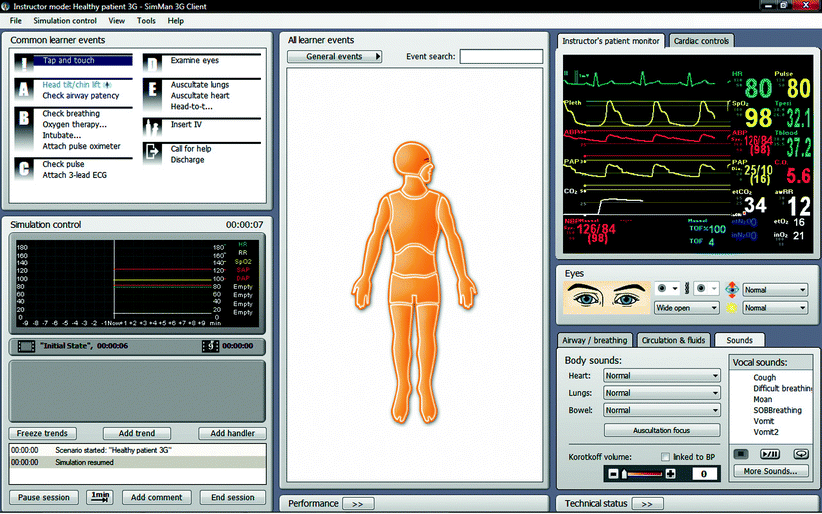
Fig. 29.2
Laerdal 3G screenshot of main screen interface (Photo courtesy of Laerdal Medical. All rights reserved)
Hospitals are now using patient simulation more frequently with practicing nurses, likely as a result of publications such as the Institute of Medicine’s report [1], To Err is Human, followed in 2003 by Keeping Patients Safe [2]. In addition, focus on safe patient care through programs such as TeamSTEPPS [3] and Quality and Safety Education for Nurses (QSEN) [4] furthers the demand for training programs using high-fidelity patient simulation.
This chapter will focus on the benefits and challenges of using high-fidelity patient simulation to educate students and staff, assess competency, develop teamwork, enhance communication, and affect patient care outcomes. Examples of how simulation is used to facilitate learning at a variety of levels will be offered. Immediate research needs and opportunities will be discussed as nurses continue to work toward integration of best practices into their work using patient simulation.
Overview of Nursing Education
While some countries have a standardized curriculum in their nursing colleges (e.g., Canada), the USA has a variety of methods for nurses to obtain their education. Prelicensure nursing programs last 2, 3, or 4 years; however, all graduates take the same licensing exam (NCLEX-RN). Curricula are approved by each individual State Board of Nursing (SBON) and no two schools are required to have the same topic order, the same amount of time dedicated to each topic, the same number of clinical and observational hours, nor the same number of hours in the laboratory environment. In addition, each SBON determines how many hours of clinical time can be completed utilizing patient simulation. The percentage currently ranges from 0 to 50%. This has resulted in confusion among the nursing programs as to how simulation can best be used to facilitate learning. It also sets the scene for nursing students to receive inequitable education.
Countries with standardized curricula do not have the problems identified in the USA; however, there are numerous other concerns that are shared by programs worldwide, including access to clinical sites and patients, ability to perform certain procedures or provide specific cares, nurse, and faculty shortages, and the complexity of today’s patients, to name but a few.
Acute care clinical sites are available at a finite number in most communities, with relatively few new hospitals built each year. Nursing programs have been pushed to increase enrollments to assuage the nursing shortage; however, clinical sites typically limit the number of students that can be on each unit at any given time. Novice students tend to be assigned clinical hours in the mornings when the majority of care and physician interactions occur. As they progress along the novice to expert continuum [5] and incorporate past experiences into their decision-making, they become more flexible in their thinking and ability to perform skills, allowing the students to be assigned to evening hours and creating additional clinical opportunities. Many programs use preceptors who are hospital staff to guide more advanced students so that faculty do not need to be present. The use of preceptors and of observational experiences is important due to the current nursing faculty shortage, which is concurrent to the overall nursing shortage.
Nursing Students
Students in many programs visit their patient the day before providing their care so that they can review the chart; talk with the physician, nurses, family, and patient; and learn what medications and treatments they will need to understand in order to provide safe care. Unfortunately, it is not uncommon for that same patient to be discharged before the student returns to provide their care. For the advanced student, it may not be difficult to reassign them a new patient with a similar condition, for example, a patient who had abdominal surgery but for a different reason. It is not that easy for the novice student who is very focused on the specifics of providing care and is unable to generalize that care to patients with similar problems.
Nursing students learn psychomotor skills either at the beginning of their program of study or at intervals throughout their program (Figs. 29.3 and 29.4).
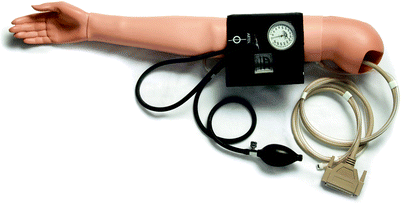
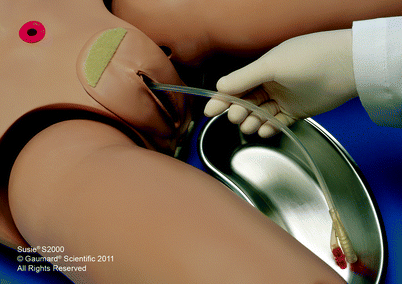

Fig. 29.3
Laerdal noninvasive blood pressure part-task trainer (Photo courtesy of Laerdal Medical. All rights reserved)

Fig. 29.4
Use of Gaumard Suse S2000 urinary catheterization part-task trainer (Photo courtesy of Gaumard® Scientific 2012. All rights reserved)
Once competency is assessed in the skills laboratory, the student is typically allowed to perform those skills under direct supervision of the clinical instructor until the instructor deems them safe to perform on their own. Sadly, it is not uncommon for students to reach the point of graduation without ever having performed some skills, such as urinary catheter insertion or nasogastric tube insertion, on a live patient.
Students are also required to have cardiopulmonary resuscitation (CPR) certification before clinically caring for patients (Fig. 29.5); however, when a crisis does arise, students are often asked to leave the patient room to allow for the response team to enter or, due to fear or anxiety, remove themselves from the situation. Students may be permitted to observe but not allowed to participate. Therefore, even the most basic of skills may not be performed in school. This creates a gap in the expectations of those who hire new graduates.


Fig. 29.5
Laerdal Resusci Anne CPR-D Simulator (based on one of the first mannequin-based simulators) (Photo courtesy of Laerdal Medical. All rights reserved)
In addition to psychomotor skills, there are procedures that new graduates are expected to know, but that they are often unable to practice in the clinical environment while in school. Many hospitals either have electronic health records (EHR) or are currently initiating their use. Due to the complexity of the EHR and staff’s perception of the difficulty of use, many hospitals no longer allow student nurses to document care on the EHR. When students are allowed, it is difficult to orient them to the EHRs, as they are often different at every institution. The same concerns exist with the various methods of obtaining and documenting medications, particularly narcotics and other scheduled medications. Due to the perceived complexity of the variety of systems utilized, students are often not allowed to give medications, or if they do, their instructor is expected to sign for them (Fig. 29.6), which breaks the medication rules in place to prevent error and ensure documentation by the correct person. In addition to procedural restrictions, students have also been restricted, in some hospitals, for caring for certain patients such as pediatric and critical care patients. Other schools must send students to facilities over 100 miles away to get these specialized experiences.
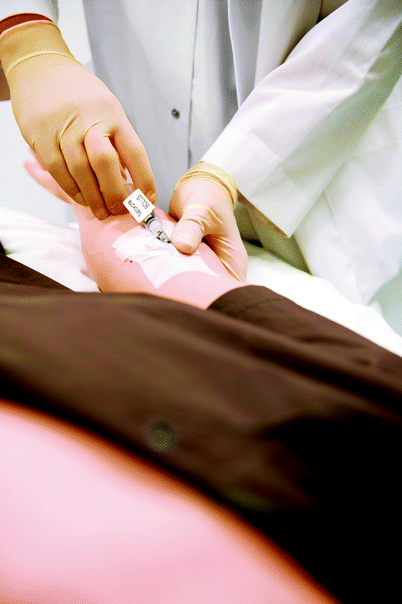

Fig. 29.6
IV drug administration through a drug recognition system (Laerdal SimMan) (Photo courtesy of Laerdal Medical. All rights reserved)
The complexity of today’s acute and chronically ill patients is astounding compared to years past (Fig. 29.7a–d). Advances in technology, medications, and treatments have been shown to keep people alive longer and with more serious illnesses and disease processes. Often, the patients who are available to be assigned to students are just too ill for those students’ level of care provision and capability. The student may need to understand advanced pathophysiology and pharmacology that they have yet to learn. The basic foundations may not have been laid for the student to understand the rationales for the care they are expected to give. This has the potential to result in an unsafe situation for the patient and requires diligence by the faculty and staff nurse assigned to the patient.
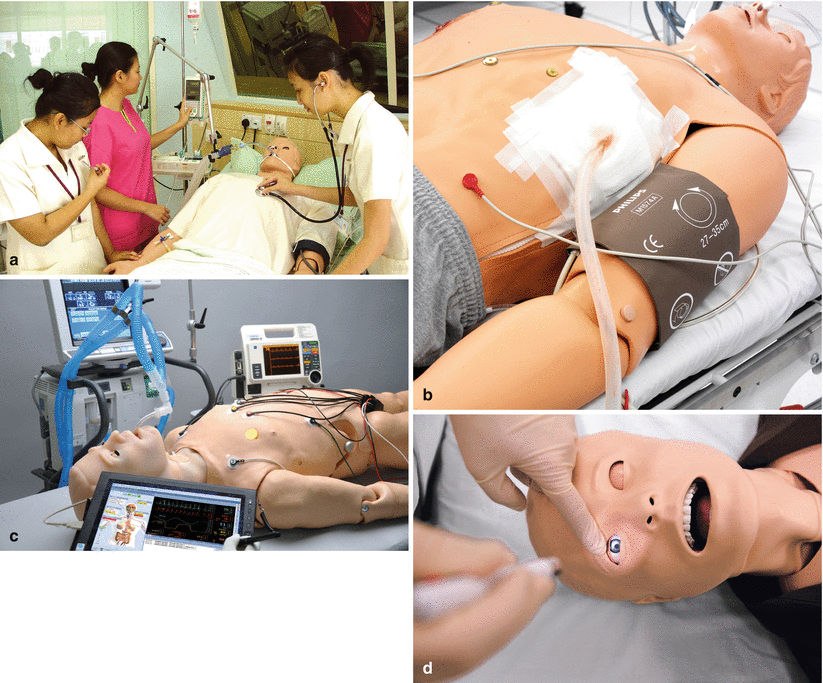

Fig. 29.7
(a) Nursing students practicing bedside ICU care using CAE METI HPS (Photo courtesy of CAE Healthcare ©2012 CAE Healthcare). (b) Chest tube management using the HPS (Photo courtesy of CAE Healthcare ©2012 CAE Healthcare). (c) Ventilator care using a Gaumard mannequin (Photo courtesy of Gaumard® Scientific 2012. All rights reserved). (d) Use of Sim Man 3G to teach neurologic assessment (Photo courtesy of Laerdal Medical. All rights reserved)
These situations help to explain why faculty and employers are concerned about the “gap” in expectations. Faculty have reported that graduates are ready to begin practice at a generalist level, but the employers of those graduates report that their new hires are not ready to care for patients [6]. Various preceptor or internship programs have been put in place, but it is not enough and educators and employers continue to work together to close this gap.
Practicing Nurses
Practicing nurses have many problems similar to the student nurses. Hospitals with IV teams have a core set of nurses who become masters at initiating IV therapy, but this may result in the remainder of the nurses losing that skill (Fig. 29.8a–b).
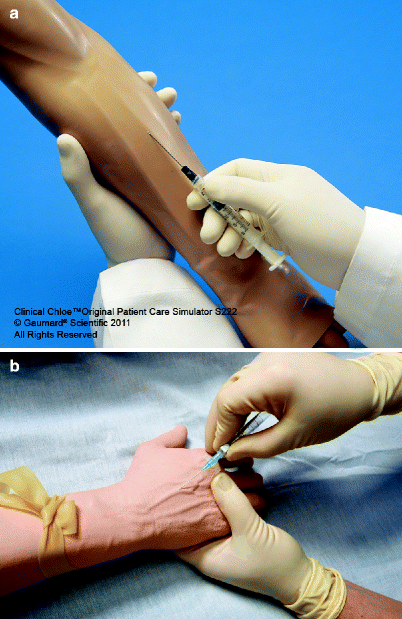

Fig. 29.8
(a) Gaumard IV training arm of Chloe™ Original Patient Care Simulator (Photo courtesy of Gaumard® Scientific 2012. All rights reserved) and (b) Laerdal IV training arm (Photo courtesy of Laerdal Medical. All rights reserved)
Similar results can happen when code teams manage all crises, as it is often heard and observed that the floor nurses “didn’t know what to do before the team arrived” [7]. Nurses need to be able to quickly identify deterioration in the high-risk, low-volume patient, but without repetition, the ability to recognize problems diminishes [8] and it becomes less likely that the patient’s problem will be caught in time.
The limitations identified in both the educational and practice environments make it clear that the use of patient simulation to educate students and nurses is one way to overcome these major issues and concerns.
Facilitating Learning with Simulation
The previous discussion lends insight into the challenges of nursing education and the difficulties to assure adequate preparation and repetition before actual clinical encounters. Repetition is critical and hones one’s ability to recognize and mange clinical situations faster [9]. These conditions can be recreated in the simulated environment and can provide repetition and the opportunity for additional patient management experiences. Here we will review the simulation technologies and the application for nursing education.
There are several types of simulation that are used in nursing education to help students understand how to care for patients that they may, or may not, encounter in the traditional clinical environment. These types of simulation range from low fidelity to high fidelity, dependent upon the type of equipment used and the way it is used by the facilitator. The higher the fidelity, the more realistic the simulation encounter.
Screen-Based Simulation
Web-Based Simulators
Second Life® (SL) is an interactive virtual web-based environment (Chap. 14) that uses avatar technology to portray patients and colleagues. This virtual environment has been used for almost a decade to teach college courses in areas as diverse as art to architecture. Medical conferences have been held in this realm as well [10]. However, comparatively little has been accomplished using this environment to teach nursing students or practicing nurses. Primary uses for SL include role-playing, collaboration, real-time interaction between students and faculty, and alternative environment for simulations [11]. Aebersold et al. [10] suggest that the virtual world of SL is an excellent environment in which to explore dangerous scenarios or those that may be difficult to simulate realistically. One drawback mentioned was the low fidelity and resolution of graphics in SL. The use of SL by a college also requires purchase of an “island” or parcel of land that can be password protected, so only students of a particular course or program could have access to specific areas. Within SL, objects such as furniture, books, and buildings need to be created by the user, requiring time to learn and develop. In Rogers’ [12] study of undergraduate nursing students learning in SL for the first time, he reported that participants were comfortable in the virtual environment, had little difficulty navigating the environment, and used trial and error methods when necessary.
Computer-Based Simulators
Another type of simulation used in nursing education is computer-based simulation. These simulations are conducted through interactive multimedia programs that can be accessed on a computer. There is typically audio and video, graphics, and teaching questions and prompts. A scenario occurs in real time, and the learner is expected to manage the patient by using nursing judgment or interventions. Feedback is provided through the program if an incorrect decision is made [13]. Bonnetain et al. [13] studied the impact of learning with computer-based simulation on medical students and found that this was a good adjunct for mannequin simulation. Strengths of this type of simulation are that the programs tend to be easy to access and can be accessed as often as desired, increase knowledge and facilitate critical thinking, pace is set by learner, and low cost. Weaknesses are lack of physical interaction, less realistic, and it is not experiential learning [14].
Stay updated, free articles. Join our Telegram channel

Full access? Get Clinical Tree








